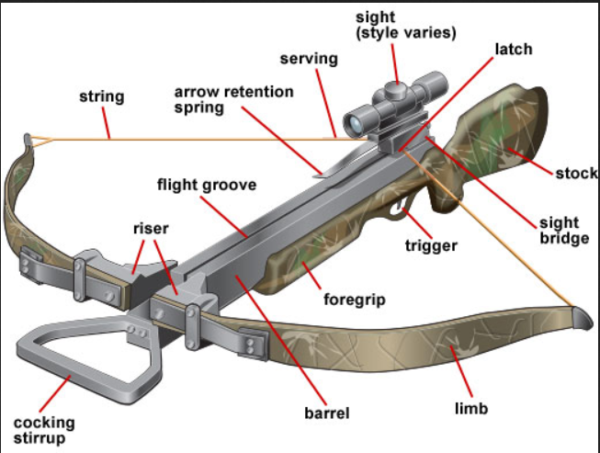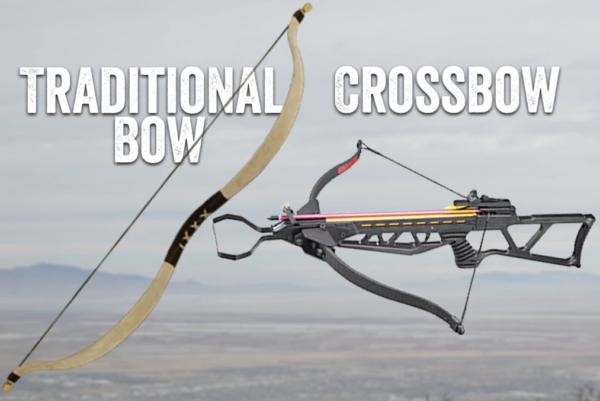Crossbows vs Longbows. What is the difference between a crossbow and a longbow? In getting to differentiate the two, I will have a detailed explanation of both bows, advantages, features and more.
What is a Crossbow?

A crossbow is an elastic ranged middle ages weapon, its made of a bow fixed on a stock and has a trigger mechanism for arrow release. Crossbows are held in a similar position just like stock guns. Crossbows have over the years evolved to the modern ones which even have scopes or sights for precision, higher speeds, and longer shooting range among other improved features.
The crossbow was one of the most important weapons in the Medieval period. It could be used by untrained soldiers and those will great power were able to penetrate armor and kill at 200 yards. Longbowmen during this period needed training and could penetrate plate mail.
What is a Longbow?

A longbow a tall bow, in most cases it’s almost the same size as the drawer, its length allows for longer draws which in turn translate into longer shooting range. The bow has narrow and elastic limbs that allow a d- shaped or circular shape for better shooting. Modern longbows are smoother, powerful and shoot at better speeds than the traditional longbows.
The Difference between Crossbows and Longbows
Both bows have the same launching principle but are very distinct, one main area of distinction is maintenance, longbows need manual maintenance of the draw by pulling the bowstring with your fingers, arm and back muscles with a lot of stamina and physical strength. Crossbows, on the other hand, use a locking mechanism for draw maintenance, this produces stronger draw weights and there is a very minimal physical strain.
Anyone can use a crossbow even without going through training, crossbows are easier to aim and load, unlike longbows which require you to use your hand to aim by holding the string back.
It is possible to load a crossbow long before the need to shoot, this facilitates surprise targets, for longbows this is not possible you have to draw the when you need to shoot.t
Crossbows especially the modern ones with scopes and other great features and more expensive than the normal or traditional longbows
In this Crossbows vs longbows article its also important to look at the different terminologies used for in both categories.
| Featured
Best Crossbow Scopes Buying Guide Barnett Crossbow Scopes Best 150 lb Crossbows |
Crossbow Terminologies
- Arbalist- a person who shoots a bow
- Arrow- what is shot from the crossbow
- Arrow/Flight Track- an opening where the arrow passes, it’s usually at the center of the crossbow
- Bolt- these are arrows specifically used for crossbows, they are shorter than the traditional arrows
- Butt Pad- this is the padding at the back of the stock that nestles into the shooter’s shoulder
- Cables- strings that run between both cams
- Cam- round wheel at the end of each limb on a compound crossbow, they act as pulleys for energy management during crossbow protection
- Cocked- the state when the string is pulled back
- Crank Cocking Device- an optional accessory on crossbows used to cock the crossbow
- Draw Weight-the amount of force in pounds used to cock a crossbow
- Dry Fire- releasing the crossbow string without proper arrow installation
- Eye Relief- The distance between the scope and the eye
- Finger Safety Reminders- these are long thin plates added to either side of the rail, they are used to prevent and discouraging the shooter from placing their fingers on the flight track to prevent injuries.
- FPS- Feet Per Second
- Limb- is the bent arm to the left or right of the center rail, it holds most of the kinetic energy when the bow is cocked
- Lube Wax- was applied on the strings regularly for optimal performance
- Nock- its the groove at the back of an arrow that touches the string.
- Picatinny Rail- mounting rail for accessories attachment
- Quiver- a tool for holding arrows or bolts
- Recurve Crossbow- its the simplest type of crossbow that uses a set of limbs or a single limb to draw the bow
- Reverse Draw Crossbow- this type of crossbow has a riser assembly built in the middle of the stock rather than the front
- Rope Cocking Device- this is a tool made of strings and small plastics handles and hooks and is used to cock crossbows
- Riser- this is the center support on a crossbow that brings the limbs together.
- Spined-Arrow stiffness
- Stirrup-the element at the front of the crossbow where the shooter places his foot for stability during the cocking process
- String Dampener- a tool on either side of the string used in noise and vibration reduction
Crossbow Safety
- Before you go out hunting crossbows it’s important to check that your crossbow is properly assembled and that you have all your hunting gear
- Always point your crossbow in the safe direction
- Wear the right gear for hunting, closed shoes
- When using the crossbow never place your fingers or thumbs on the flight track to avoid serious injuries
- The only way to decock is to shoot safely
- Never dry fire
- Keep your finger off the trigger until you are ready to shoot, this avoids dry firing
- Only load the right arrows, arrows of the recommended size, stiffness, length, weight and those with a moon or half-moon nocks
- Before firing always make sure that the crossbow is fully cocked
- Do constant maintenance procedures
Longbows Terminologies
- Anchor point- this is the reference point on a shooters face its located by the drawing hand in order to give a consistent draw length and arrow release
- Archers paradox- this is how an arrow bends around the handle of a longbow
- Arrow plate- this is a slice of hard material that is attached to the bow where the arrow passes, it stops wear on the wood
- Backing- is the material glued to the back of the bow, it reduces breakage under tension and improves performance
- Belly- this is the surface towards you as you draw the bow
- Billets- these are two pieces of wood that are joined together to make a complete bow
- Bracing a bow -stringing the bow
- Carriage bow- is a bow that folds or separates at the handle making it easy for transportation
- Composite bow- this a bow that has limbs made from two or more materials
- Drawing- the act of pulling the bowstring in order to shoot
- Flatbow- is a bow that has much wider limbs than they are deep
- Finger tab- is a small piece of leather worn on the hand to protect the fingers when you pull the string
- Flight arrow- an arrow made for shooting long distances, it has y small-sized fletching, a barrelled shaft and is lightweight
- Footed arrow- an arrow with the front section of the shaft made of harder wood varieties
- Hand shock-this is what is felt on the hand after the arrow is released
- Knot- a portion of wood where there was a growth of a branch from the trunk
Longbows Safety
- Only point in safe directions and only shoot when it’s safe
- Be sure of the target
- Never shoot over a ridge
- Check the bowstring regularly
- Avoid dry-firing a bow to prevent injuries
- Wear an armguard and finger protection
- Handle arrows carefully
- Immediately repair defects
- Check for cracks or dents before use
- Store properly
- Store arrows in quivers
See Also
10 Best 4×32 Crossbow Scopes [Barnett,Truglo,Centerpoint,UTG,Halo,Horton]
